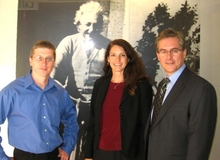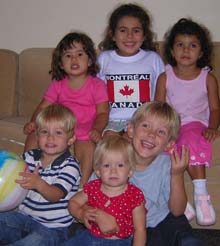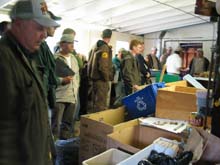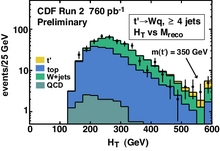 | Thursday, October 5, 2006 |
|
Thursday, October 5
Friday, October 6 Click here for a full calendar with links to additional information. |
|
Extended Forecast |
Secon Level 3 |
|
Thursday, October 5 -Portabello Harvest Grain -Philly Style Cheese Steak -Garlic Herb Roasted Pork -Tomato Basil Chicken Parmesan -Southwestern Turkey Wrap -Assorted Slice Pizza -Marinated Grilled Chicken Cesar Salads |
|
Thursday, October 5 Dinner Booked
Wednesday, October 11 |
| Fermilab Today is online at: http://www.fnal.gov/today/ Send comments and suggestions to today@fnal.gov Fermilab Today archive Hurricane Relief Page Fermilab Today PDF Version Fermilab Result of the Week archive Fermilab Safety Tip of the Week archive Linear Collider News archive Fermilab Today classifieds Subscribe/Unsubscribe to |
| Seed from chaff: Fermilab gives tips to ecology team | ||
| ||
|
The Chicago Wilderness Natural Resources Management Team came to Fermilab yesterday to learn more about prairie restoration projects at the lab. During the tour, Bob Lootens described how Roads and Grounds uses a seed-drying wagon (designed and built by Fermilab's Gary Konen) and a broadcast prairie-seed spreader for harvest and re-planting. He also described how to account for various conditions, such as high wind when spreading seed, and techniques for bringing back first-wave species, like trimming newer growth to let in sunlight.
The group also visited the seed processing building (shown above), where an old fanning mill separates the seed from the chaff for springtime planting. The room contained baby-food jars with cancer root, coffee cans with May apple, a shopping bag full of sweet black-eyed Susan, and more. "We're interested in learning the techniques Fermilab uses to develop prairies," said visitor Jerry Atteve, an ecological restoration intern with the Village of Glenview. "It can give us new ideas for how to maintain and improve our prairies."
Fermilab's annual prairie seed harvest will take place this weekend. To learn more, visit Fermilab's ecology website.
|
|
SLAC Today, October 4, 2006: Stanford Chemist Receives Nobel for Work Conducted in Part at SSRL Congratulations to Stanford Professor Roger D. Kornberg, who has been awarded the Nobel Prize in Chemistry for resolving the machinery that gives voice to DNA. Kornberg carried out a significant part of the research contributing to this prize at the Stanford Synchrotron Radiation Laboratory (SSRL).
In order for our bodies to make use of the information stored in the genes, a copy must first be made and transferred to the outer parts of the cells. There it is used as an instruction for protein production-it is the proteins that in their turn actually construct the organism and its function. The copying process is called transcription. Roger Kornberg was the first to create an actual picture of how transcription works at a molecular level in the important group of organisms called eukaryotes (organisms whose cells have a well-defined nucleus). Mammals like ourselves are included in this group, as is ordinary yeast.
|
| What tops top? | ||
| ||
|
Physicists always want to know more. Quarks appear to come in three "generations," with the heaviest quark, the
top, being a member of the third generation. But can there be a fourth
generation? Or perhaps another heavy particle that can mimic the top as
suggested by some extensions of the Standard Model?
Physicists in the CDF experiment set out to look for a heavier version of the top quark, dubbed the t' ("tee prime"), using a similar technique they use to measure the production rate of pairs of top quarks. To measure top, physicists make use of its heaviness to distinguish it from the less-heavy backgrounds in the data sample. The signal for a new t' quark would be events with an even larger apparent mass or total energy. Using a large sample of Tevatron data collected up to 2006, CDF physicists calculated simultaneously the total energy deposited in the event, and the apparent mass of the quark that might be decaying. Alas, there is no large excess of events beyond that expected from the top and the expected Standard Model backgrounds. Though absence of evidence is not evidence of absence, if there had been a t' with mass less than one and a half times the top quark mass, the researchers would have found it in this sample of data. With the record-setting luminosities enjoyed at the Tevatron these days, these physicists can continue the search for what might be lurking there, over the top. Click here for further reading | ||
 |
||
The CDF team searching for massive top-like particles (from left): Andrew Ivanov, Robin Erbacher and John Conway of UC Davis. Not shown: Amit Lath (Rutgers); Rob Roser (FNAL); Kevin Lannon, Richard Hughes and Brian Winer (OSU).
| Result of the Week Archive
|
|
|
October 2 - 4 - Storms and lightning strikes responsible for no integrated luminosity during the last 2 days.
Read the Current Accelerator Update |
|
Professional Development
Argonne open house
Fermilab volunteers needed
Fermilab celebrates Illinois On Wednesday, October 11 at 7:00 p.m., artist Sallie Wolf will present "Moon Music: How observing the moon led to the creation of a modern Gregorian chant." The performance will take place in the Fermilab Art Gallery on the 2nd floor of Wilson Hall. On Friday, October 13 at 7:00 p.m., Jim Jenkins will present "The Ah-Ha Moment," a discussion and slide presentation about his work. The show will take place at Geneva City Hall, 22 South 1st Street, Geneva. If you have questions, please contact Georgia Schwender at 630-840-6825 or georgia@fnal.gov. |


